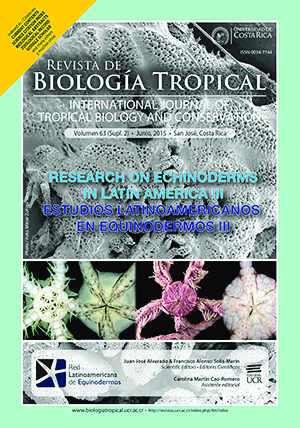Abstract
There are three main species of regular sea urchins in the Canary Islands. To establish the optimal fishing seasons for two of them, we studied the evolution of the gonadal index in several years and locations, of Paracentrotus lividus (April 2006 to March 2008 on Tenerife island in two locations: Las Galletas and La Jaca and from April 2006 to January 2009 in Gran Canaria island in two locations: Ojos de Garza and Gando), and Diadema africanum (January 2010 to May 2011 on Gran Canaria island in three locations: Risco Verde, Arguineguin and Agaete). In the case of P. lividus, located on the southern edge of their distribution, the presence of several annual maximum gonadal indez peak was observed, probably related to the temperature. These times of gonadal index increases corresponded to the stages of maturation. The main period of maturity coincided with the fall and early winter (August, October and December). There was sporadic emissions of gametes depending on location, in April, during the summer (June, July or August), autumn (September or October) and winter (December, January or February). This fragmented situation is possibly due to exposure to the hydrodynamic area’s and food abundance. The maximum presence of D. africanum occurred in the months of May to June, with virtually no variations throughout the year, in the southernmost locality (Arguineguin). In conclusion, the two species of sea urchins would be complementary shellfish resources, as their periods of maximum GI (Gonadal Index, capture time) do not overlap during the year.
References
Bacallado, J. J., Brito, A., Cruz, T., Carrillo, M., & Barquín, J. (1987). Proyecto Bentos II. Anexo: Estudio de la biología del erizo de lima (Diadema antillarum) (Informes para la Consejería de Agricultura y Pesca del Gobierno de Canarias) Gran Canarias: Gobierno de Gran Canarias.
Brito, A., Gil-Rodríguez, M. C., Hernández, J. C., Falcón, J. M., González, G., García, N., Cruz, A., Herrera, G., & Sancho, A. (2002). Estudio de la biología y ecología del erizo Diadema antillarum y de las comunidades de sucesión en diferentes zonas de blanquizal del Archipiélago Canario. Gran Canarias: Viceconsejería de Medio Ambiente, Departamento de Biología Animal (Ciencias Marinas), Universidad de La Laguna.
Byrne, M. (1990). Annual reproductive cycles of the commercial sea urchin Paracentrotus lividus from an exposed intertidal and a sheltered habitat on the west coast of Ireland. Marine Biology, 104, 275-289.
Garrido, M., Haroun, R. J., & Lessios, H. A. (2000). Annual reproductive periodicity of the sea urchin Diadema antillarum Phillipi in the Canary Islands. Bulletin of Marine Science, 67, 989-996.
Girard, D., Hernández, J. C., Toledo, K., & Clemente, S. (2006). Aproximación a la biología reproductiva del equinoideo Paracentrotus lividus (Lamark 1816) en el litoral de Tenerife. Barcelona: Libro de Resúmenes XIV SIEBM.
Girard, D., Clemente, S., Toledo-Guedes, K., Brito, A., & Hernandez, J. C. (2012). A mass mortality of subtropical intertidal populations of the sea urchin Paracentrotus lividus: analysis of potential links with environmental conditions. Marine Ecology, 33, 377-385.
Garrido, M. (2003). Contribución al conocimiento de Diadema antillarum Philippi 1845, en Canarias (Tesis de doctorado). Universidad de Las Palmas de Gran Canaria, Gran Caanria.
Hernández, J. C., Toledo, K., Girard, D., Clemente, S., Cubero, E., & Brito, A. (2005). Descripción de la post-larva y primeras fases juveniles de tres equinoideos presentes en las islas Canarias: Diadema antillarum Philippi, 1845, Paracentrotus lividus (Lamarck, 1816) y Arbaciella elegans Mortensen, 1910. Vieraea, 33, 385-397.
Hernández, J. C., Brito, A., García, N., Gil-Rodríguez, M. C., Herrera, G., Cruz-Reyes, A., & Falcón, J. M. (2006) Spatial and seasonal variation of the gonad index of Diadema antillarum (Echinodermata: Echinoidea) in the Canary Islands. Scientia Marina, 70, 689-698.
Hernández, J. C., Clemente, S., & Brito, A. (2007). Sex-ratio and occurrence of hermaphroditism in populations of Diadema antillarum (Echinoidea: Diadematidae) at two contrasting habitats in Tenerife (Canary Islands). Vieraea, 35, 155-161.
Herrero, A. (2008). Aspectos reproductivos del erizo común (Paracentrotus lividus) en aguas del este de Gran Canaria. Manuscrito inédito.
Lozano, J., Galera, J., Lopez, S., Turón, X., Palacín, C., & Morera, G. (1995). Biological cycles and recruitment of Paracentrotus lividus (Echinodermata: Echinoidea) in two contrasting habitats. Marine Ecology Progress Series, 122, 179-191.
Meidel, S. K., & Scheibling, R. E. (1998) Annual reproductive cycle of the green sea urchin, Strongylocentrotus droebachiensis, in differing habitats in Nova Scotia, Canada. Marine Biology, 131, 461-478.
Portillo-Hahnefeld, A. (2010) Lyfe cycle of Diadema antillarum (Echinodermata). Islas Canarias: Editorial Asociación Oceanográfica de Canarias.
Sánchez-España, A. I., Martínez-Pita, I., & García, F. J. (2004) Gonadal growth and reproduction in the comercial sea urchin Paracentrotus lividus (Lamarck, 1816) (Echinodermata: Echinoidea) from southern Spain. Hydrobiología, 519, 61-72.
Shpigel, M., McBride, S. C., Marciano, S., & Lupatsch, I. (2004). The effect of photoperiod and temperature on the reproduction of European sea urchin, Paracentrotus lividus. Aquaculture, 232, 343-355.
Spirlet, C., Grosjean, P., & Jangoux, M. (1998). Reproductive cycle of the echinoid Paracentrotus lividus: analysis by means of maturity index. Invertebrate Reproduction and Development, 34, 69-81.
Turon, X., Giribert, G., López, S., & Palacín, C. (1995). Growth and population structure of Paracentrotus lividus (Echinodermata: Echinoidea) in two contrastings habitat. Marine Ecology Progress Series, 122, 193-204.
Tuya, F., Cisneros-Aguirre, J., Ortega-Borges, L., & Haroun, R. J. (2007). Bathymetric segregation of sea urchins on reefs of the Canarian Archipelago: Role of flow-induced forces. Estuarine, Coastal, Shelf Science, 73, 481-488.
Tuya, F., Boyra, A., Sanchez-Jerez, P., Barbera, C., & Haroun, R. J. (2004) Relationships between rocky-reef fish assemblages, the sea urchin Diadema antillarum and macroalgae throughout the Canarian Archipelago. Marine Ecology Progress Series, 278, 157-169.
Vaïtilingon, D., Morgan, R., Grosjean, P., Gosselin, P., & Jangoux, M. (2001). Effects of delayed metamorphosis and food rations on the perimetamorphic events in the echinoid Paracentrotus lividus (Lamarck, 1816) (Echinodermata). Journal of Experimental Marine Biology and Ecology, 262, 41-60.
Vega, W., & Romero, V. (2011). Patrón de distribución espacial de Paracentrotus lividus. Anales Universitarios de Etología, 5, 21-30.
Comments

This work is licensed under a Creative Commons Attribution 4.0 International License.
Copyright (c) 2015 Revista de Biología Tropical






